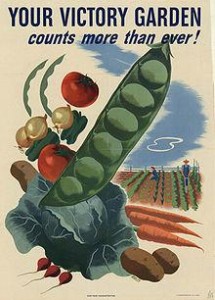Urban Farms or Myths?
Feeding Ourselves, Our Cities, and the World…
by Devon G. Peña
The excitement surrounding urban agriculture is partly rooted in a notable history and possible future capacity to actually help feed the entire nation. During the Second World War, so-called ‘Victory Gardens’ provided close to half of the fruits and vegetables  consumed by the population; albeit, people in those days ate smaller, healthier portions. Perhaps the revival of urban farming will lead not just to a diet for a small planet but a diet for smaller people?
consumed by the population; albeit, people in those days ate smaller, healthier portions. Perhaps the revival of urban farming will lead not just to a diet for a small planet but a diet for smaller people?
Victory Gardens, a.k.a. ‘War Gardens’, played a major role in the mobilization of the civilian population during the two world wars but were especially important during the Second World War. Most reliable estimates confirm that 40 to 50 percent of the fruits and vegetables consumed during this period were grown in urban gardens.
The return of urban farming echoes these monumental efforts of the past, but the new ‘Victory Gardens’ are about a victory over poverty, hunger, malnutrition, and the dissolution of community ties. The phenomenal success and rapid growth of urban farming has created extraordinary opportunities for food justice and an ecologically superior, community-based approach to reinvention of our current food system, which is dominated by unsustainable and inequitable industrial models and a profit-driven top-down corporate anti-nature and anti-worker rationality. (more…)
